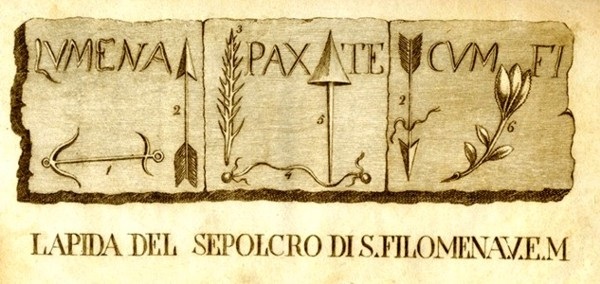On May 24, 1802, the fossors who worked to free Priscilla’s catacombs from materials and rubble built up over the centuries had reached its centre, not far from the Greek Chapel, very close to the skylight (fig.5). One of them, who remains unknown, when removing the soil from one of the tunnels, hit some tiles which had kept a niche closed.

Following the instructions received by Mons. Ponzetti, the worker stopped and went to report his finding to Fr. Filippo Ludovice, a second caretaker.
On May 25, 1802, Ludovici, accompanied by many witnesses, one of whom was another priest, went down in the catacombs and, under his supervision, the fossor kept digging, finding the funeral stone of a small tomb which looked like one of an adolescent.
It was made of three tiles on which was the writing: “LUMENA – PAX TE – CUM FI”. Also there were engraved two anchors, three arrows, a palm, and a flower. In the niche there was also a broken vial, containing a blackish, dried up residue (fig.6). The venerable relics were carefully wrapped in five wrappers and stored in a duly authenticated wooden box. They were transferred with the usual formalities to the Relics Treasury in Rome, while the tiles were transferred first to the College Massimo of the Jesuits in Rome and then to the Museum of the Christian Antiquities in the Vatican.
Donation of Saint Philomena’s body to priest Don Francesco De Lucia, through Mons. Bartolomeo De Cesare, Bishop of Potenza.
Since then, St. Philomena soon made herself known throughout the world by the thousands of miracles she worked and multiple favors she granted. Those miracles continue today. "Pray to St. Philomena. Whatever you ask from her she will obtain for you," said Pope Gregory XVI.


 RSS Feed
RSS Feed
